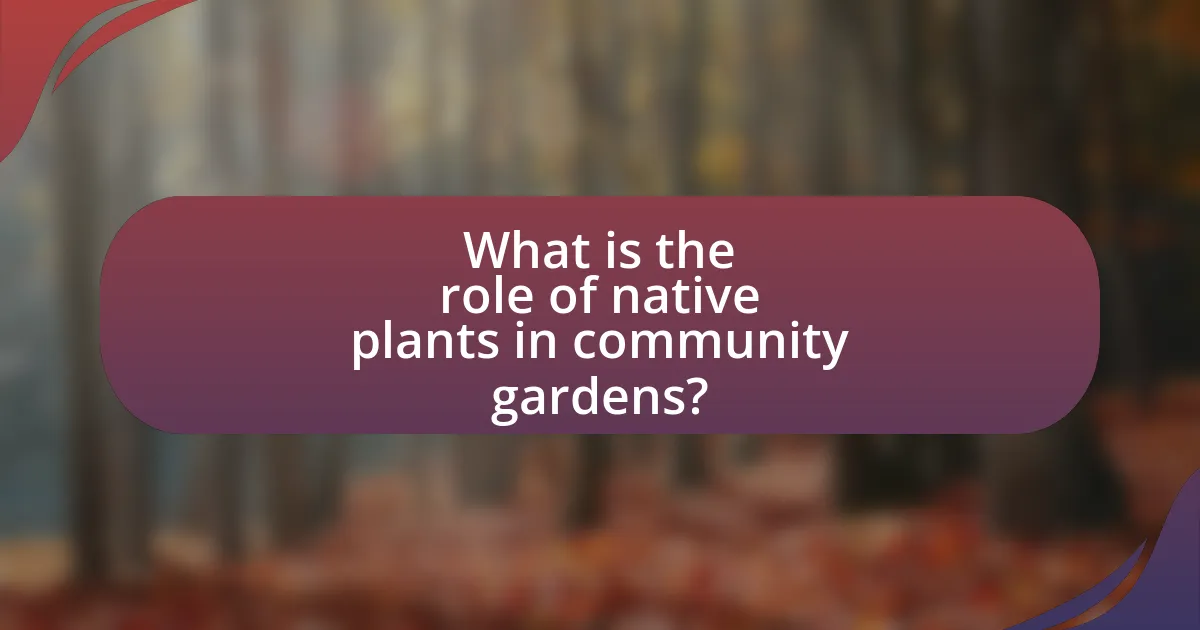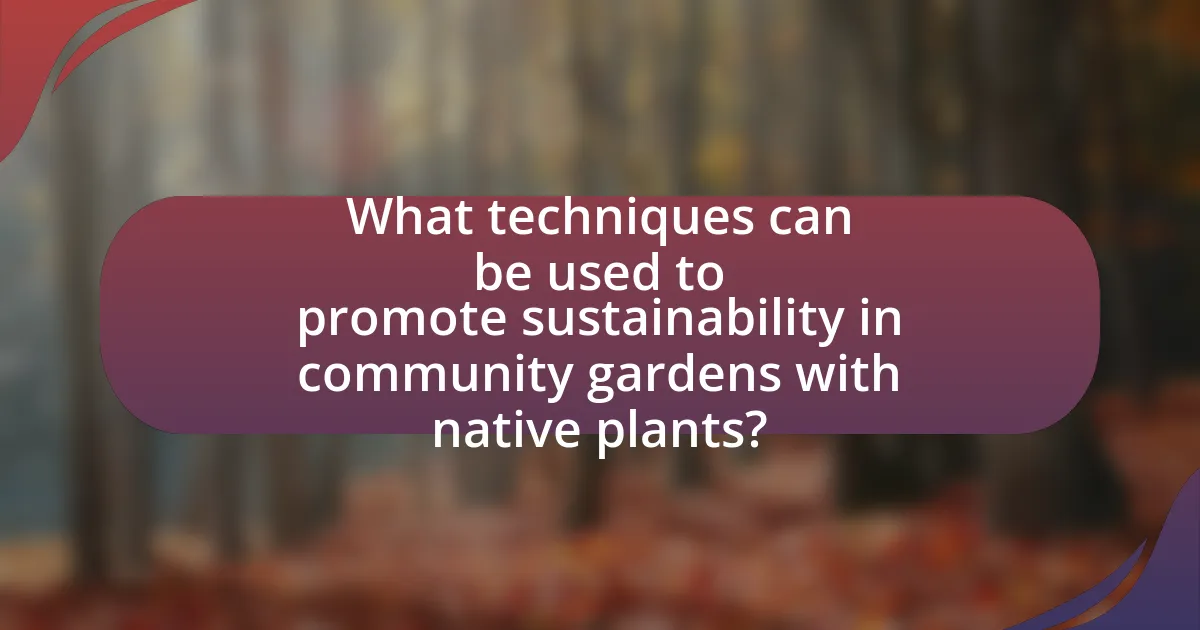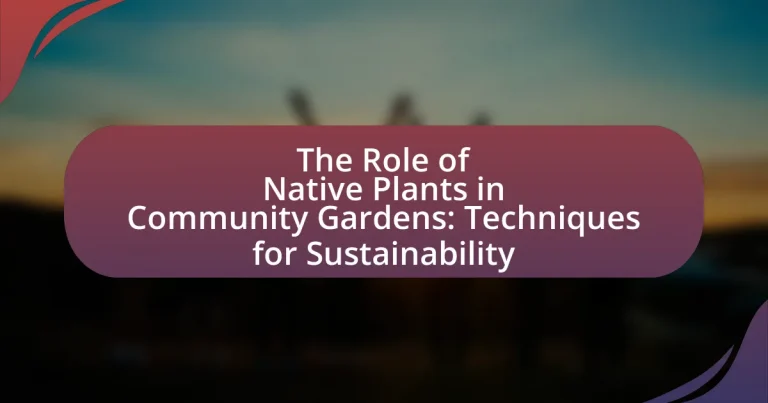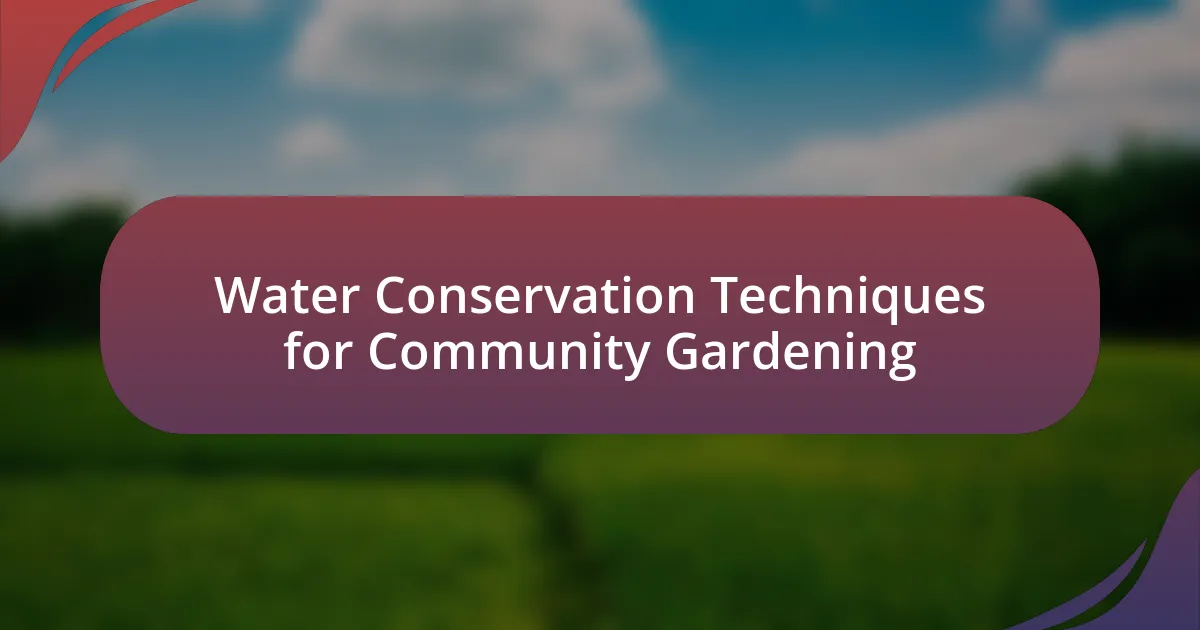The article focuses on the role of native plants in community gardens and their significance for sustainability. It outlines how native plants enhance biodiversity, support local ecosystems, and contribute to soil health while requiring less maintenance and resources compared to non-native species. Key topics include the benefits of native plants for pollinators and wildlife, techniques for sustainable gardening practices, challenges faced in incorporating native plants, and strategies for community engagement and education. The article also discusses the long-term advantages of integrating native plants into community gardens, including economic benefits and improvements in community health and well-being.

What is the role of native plants in community gardens?
Native plants play a crucial role in community gardens by enhancing biodiversity and supporting local ecosystems. These plants are adapted to the local climate and soil conditions, which makes them more resilient and less resource-intensive compared to non-native species. Research indicates that native plants attract pollinators, such as bees and butterflies, which are essential for the reproduction of many garden crops. Additionally, they require less water and maintenance, contributing to sustainable gardening practices. Studies have shown that gardens featuring native plants can increase local wildlife populations and improve soil health, thereby fostering a more balanced and productive gardening environment.
How do native plants contribute to biodiversity in community gardens?
Native plants enhance biodiversity in community gardens by providing habitat and food sources for local wildlife, including pollinators and beneficial insects. These plants are adapted to the local environment, which allows them to thrive with minimal maintenance and support a diverse range of species. Research indicates that gardens featuring native plants can support up to 50% more species of pollinators compared to those with non-native species, thereby promoting ecological balance and resilience. Additionally, native plants contribute to soil health and water conservation, further supporting a diverse ecosystem within community gardens.
What specific benefits do native plants provide to local ecosystems?
Native plants provide essential benefits to local ecosystems by enhancing biodiversity, supporting wildlife, and improving soil health. These plants are adapted to local conditions, which allows them to thrive without the need for excessive water or fertilizers, thus conserving resources. Research indicates that native plants attract a variety of pollinators, such as bees and butterflies, which are crucial for the reproduction of many flowering plants and the overall health of the ecosystem. Additionally, native plants contribute to soil stability and prevent erosion through their extensive root systems, which also improve soil structure and nutrient cycling. Studies have shown that areas with a higher diversity of native plants tend to support more diverse animal populations, creating a balanced and resilient ecosystem.
How do native plants support pollinators and other wildlife?
Native plants support pollinators and other wildlife by providing essential food sources and habitats. These plants produce nectar and pollen that attract various pollinators, such as bees, butterflies, and hummingbirds, which are crucial for the reproduction of many flowering plants. Research indicates that native plant species are more effective at supporting local pollinator populations compared to non-native species, as they have co-evolved with these organisms, offering the specific resources they need. For example, a study published in the journal “Ecological Applications” by Tallamy and Shriver (2018) found that landscapes dominated by native plants can support up to 50% more pollinator species than those with non-native plants. Additionally, native plants create habitats for other wildlife, including birds and beneficial insects, contributing to biodiversity and ecosystem health.
Why are native plants important for sustainable gardening practices?
Native plants are crucial for sustainable gardening practices because they are well-adapted to local climates and soils, requiring less water and maintenance compared to non-native species. Their deep root systems improve soil health and reduce erosion, while they also provide habitat and food for local wildlife, promoting biodiversity. Studies show that gardens with native plants can support up to 50% more wildlife than those with non-natives, enhancing ecosystem resilience. Additionally, native plants are more resistant to local pests and diseases, reducing the need for chemical interventions, which aligns with sustainable gardening principles.
How do native plants reduce the need for chemical fertilizers and pesticides?
Native plants reduce the need for chemical fertilizers and pesticides by enhancing soil health and promoting biodiversity. Their deep root systems improve soil structure and nutrient availability, which decreases reliance on synthetic fertilizers. Additionally, native plants attract beneficial insects and pollinators, which naturally control pest populations, thereby minimizing the need for chemical pesticides. Research indicates that gardens with native plants can support a higher diversity of beneficial species, leading to more effective pest management and healthier ecosystems.
What role do native plants play in soil health and erosion control?
Native plants significantly enhance soil health and control erosion. Their deep root systems improve soil structure, increase organic matter, and promote nutrient cycling, which leads to healthier soil. Additionally, native plants stabilize soil through their extensive root networks, reducing surface runoff and preventing soil erosion during heavy rainfall. Research indicates that areas with native vegetation experience up to 50% less erosion compared to those with non-native species, demonstrating their effectiveness in maintaining soil integrity and health.
What challenges do community gardens face when incorporating native plants?
Community gardens face several challenges when incorporating native plants, primarily related to community awareness, maintenance, and biodiversity. Many community members may lack knowledge about the benefits and ecological importance of native plants, leading to resistance or indifference towards their inclusion. Additionally, native plants often require specific care and conditions that differ from traditional garden plants, which can complicate maintenance efforts. Furthermore, integrating native plants into existing garden ecosystems can disrupt established biodiversity, as the introduction of new species may affect local flora and fauna dynamics. These challenges highlight the need for education and strategic planning in community gardening initiatives focused on sustainability.
How can community gardeners overcome resistance to using native plants?
Community gardeners can overcome resistance to using native plants by educating their peers about the ecological benefits and low maintenance requirements of these plants. Research indicates that native plants support local wildlife, including pollinators, and require less water and fertilizer compared to non-native species, making them more sustainable choices for gardens. By organizing workshops and providing informational materials that highlight these advantages, community gardeners can effectively address misconceptions and demonstrate the value of native plants in enhancing biodiversity and garden resilience.
What are common misconceptions about native plants in gardening?
Common misconceptions about native plants in gardening include the belief that they require no maintenance, that they are unattractive, and that they are only suited for specific regions. While native plants are generally low-maintenance compared to non-native species, they still require care such as watering and occasional pruning. Additionally, many native plants offer aesthetic appeal with diverse colors and forms, challenging the notion that they are unattractive. Furthermore, native plants can thrive in various environments, not just their original habitats, making them versatile choices for gardeners in different regions.

What techniques can be used to promote sustainability in community gardens with native plants?
Techniques to promote sustainability in community gardens with native plants include implementing organic gardening practices, utilizing rainwater harvesting, and fostering biodiversity through companion planting. Organic gardening practices, such as avoiding synthetic fertilizers and pesticides, enhance soil health and reduce chemical runoff, which is crucial for maintaining ecosystem balance. Rainwater harvesting systems can efficiently collect and store rainwater for irrigation, reducing reliance on municipal water sources and promoting water conservation. Additionally, companion planting with native species encourages beneficial insect populations and improves plant resilience, leading to a more sustainable garden ecosystem. These techniques collectively support environmental health and resource efficiency in community gardens.
How can community gardens effectively select native plants for their specific environment?
Community gardens can effectively select native plants for their specific environment by conducting thorough site assessments and engaging local ecological expertise. Site assessments involve analyzing soil type, moisture levels, sunlight exposure, and existing flora and fauna, which helps identify the most suitable native plants for the conditions. Engaging local ecological experts, such as botanists or horticulturists, provides insights into native plant species that thrive in the area, ensuring that selections are ecologically appropriate. Research indicates that using native plants enhances biodiversity and resilience in local ecosystems, as native species are adapted to local conditions and support local wildlife.
What factors should be considered when choosing native plants for a garden?
When choosing native plants for a garden, factors such as local climate, soil type, water availability, and ecological compatibility should be considered. Local climate influences plant survival and growth, as certain species thrive in specific temperature and precipitation ranges. Soil type affects nutrient availability and drainage, which are critical for plant health. Water availability is essential, as native plants often have varying drought tolerance levels. Ecological compatibility ensures that selected plants support local wildlife, such as pollinators and birds, promoting biodiversity. Research indicates that using native plants can reduce water usage by up to 50% compared to non-native species, highlighting their sustainability benefits.
How can gardeners assess the suitability of native plants for their local climate?
Gardeners can assess the suitability of native plants for their local climate by evaluating factors such as soil type, moisture levels, temperature ranges, and local weather patterns. Understanding the specific environmental conditions of their area allows gardeners to select native species that are adapted to thrive in those conditions. For instance, native plants often have evolved traits that enable them to withstand local droughts or heavy rainfall, making them more resilient than non-native species. Research indicates that using native plants can enhance biodiversity and reduce water usage, as they typically require less maintenance and irrigation once established.
What methods can be employed to maintain native plants in community gardens?
To maintain native plants in community gardens, regular monitoring and adaptive management practices should be employed. This includes assessing plant health, controlling invasive species, and ensuring appropriate watering and mulching techniques. Research indicates that native plants are more resilient to local pests and diseases, which reduces the need for chemical interventions. Additionally, community involvement in maintenance activities fosters stewardship and enhances biodiversity, as evidenced by studies showing increased plant survival rates in community-managed gardens.
How does proper watering and mulching contribute to the sustainability of native plants?
Proper watering and mulching significantly enhance the sustainability of native plants by maintaining soil moisture and regulating temperature. Adequate watering ensures that native plants receive the necessary hydration to thrive, especially during dry periods, which is crucial for their growth and reproduction. Mulching, on the other hand, helps retain soil moisture, reduces evaporation, and suppresses weed growth, creating a more favorable environment for native plants. Research indicates that mulched areas can retain up to 70% more moisture compared to unmulched areas, thereby supporting plant health and resilience. Together, these practices promote the longevity and ecological balance of native plant communities in gardens.
What are the best practices for pruning and managing native plants?
The best practices for pruning and managing native plants include understanding their growth habits, timing pruning appropriately, and using proper techniques to promote health and resilience. Native plants typically require minimal pruning, but when necessary, it is best to prune during their dormant season to minimize stress and encourage new growth. Techniques such as selective pruning, which involves removing dead or diseased branches, can enhance air circulation and light penetration, fostering a healthier plant environment. Additionally, maintaining soil health through mulching and appropriate watering practices supports the overall management of native plants, ensuring they thrive in community gardens. Research indicates that well-managed native plants can enhance biodiversity and ecosystem services, making them valuable assets in sustainable gardening practices.
How can community engagement enhance the sustainability of native plant initiatives?
Community engagement enhances the sustainability of native plant initiatives by fostering local stewardship and increasing awareness of ecological benefits. When community members actively participate in planting, maintaining, and promoting native plants, they develop a personal connection to the environment, which leads to greater commitment to conservation efforts. Research indicates that community-driven projects, such as those involving native plant gardens, can improve biodiversity and ecosystem resilience, as seen in studies conducted by the University of California, which found that community involvement significantly boosts the success rates of native plant restoration efforts. Engaged communities are also more likely to advocate for policies that support native plant initiatives, further ensuring their long-term sustainability.
What strategies can be used to educate the community about the benefits of native plants?
To educate the community about the benefits of native plants, strategies such as organizing workshops, creating informational materials, and establishing community gardens can be employed. Workshops can provide hands-on experiences and expert knowledge, demonstrating how native plants support local ecosystems and require less maintenance. Informational materials, including brochures and online resources, can highlight the ecological advantages of native plants, such as their role in supporting pollinators and improving soil health. Establishing community gardens with native plants allows residents to see their benefits firsthand, fostering a deeper appreciation and understanding of their importance in sustainable gardening practices.
How can volunteers be effectively organized to support native plant gardening efforts?
Volunteers can be effectively organized to support native plant gardening efforts by implementing structured training programs and clear communication channels. Structured training equips volunteers with the necessary knowledge about native plants, their ecological benefits, and gardening techniques, which enhances their effectiveness. For instance, organizations like the National Wildlife Federation provide resources and workshops that educate volunteers on native plant species and sustainable gardening practices. Clear communication channels, such as regular meetings and digital platforms, facilitate coordination and ensure that volunteers are informed about tasks, schedules, and project goals. This approach fosters a sense of community and commitment among volunteers, ultimately leading to more successful native plant gardening initiatives.

What are the long-term benefits of integrating native plants into community gardens?
Integrating native plants into community gardens provides long-term benefits such as enhanced biodiversity, improved soil health, and increased resilience to climate change. Native plants support local wildlife, including pollinators, which are essential for ecosystem balance; studies show that gardens with native flora can attract up to 50% more pollinators compared to those with non-native species. Additionally, native plants are adapted to local soil and climate conditions, requiring less water and maintenance, which leads to healthier soil over time. Research indicates that native plants can improve soil structure and fertility, promoting sustainable gardening practices. Furthermore, these plants contribute to climate resilience by reducing the need for chemical fertilizers and pesticides, thereby fostering a more sustainable environment in community gardens.
How do native plants impact community health and well-being?
Native plants positively impact community health and well-being by enhancing biodiversity, improving air quality, and providing mental health benefits. Biodiversity is crucial for ecosystem resilience; native plants support local wildlife, including pollinators, which are essential for food production. Improved air quality results from native plants’ ability to filter pollutants and produce oxygen, contributing to healthier living environments. Additionally, studies show that green spaces with native vegetation can reduce stress and promote physical activity, leading to better mental health outcomes. For instance, research published in the Journal of Environmental Psychology indicates that exposure to natural environments, including those with native plants, significantly enhances mood and reduces anxiety.
What psychological benefits do green spaces with native plants provide to residents?
Green spaces with native plants provide significant psychological benefits to residents, including reduced stress, improved mood, and enhanced overall well-being. Research indicates that exposure to natural environments, particularly those featuring native flora, can lower cortisol levels, which are associated with stress. A study published in the Journal of Environmental Psychology found that individuals who spent time in green spaces reported higher levels of happiness and life satisfaction compared to those in urban settings devoid of nature. Furthermore, native plants support local biodiversity, which can foster a sense of community and connection among residents, contributing to improved mental health outcomes.
How can native plants improve air and water quality in urban areas?
Native plants improve air and water quality in urban areas by enhancing biodiversity and promoting ecosystem services. These plants filter pollutants from the air, reducing particulate matter and improving overall air quality. For instance, studies show that urban vegetation can absorb up to 30% of airborne pollutants, including nitrogen dioxide and sulfur dioxide. Additionally, native plants contribute to water quality by reducing runoff and promoting groundwater recharge. Their deep root systems allow for better water infiltration and filtration, which helps to mitigate flooding and decrease the amount of pollutants entering waterways. Research indicates that urban green spaces with native vegetation can reduce stormwater runoff by up to 65%, thereby improving the quality of water that reaches local streams and rivers.
What economic advantages do community gardens with native plants offer?
Community gardens with native plants offer significant economic advantages, including reduced maintenance costs and increased local food production. Native plants require less water and fewer chemical inputs, leading to lower expenses for gardeners. Additionally, these gardens can enhance property values in surrounding areas, as studies have shown that green spaces contribute positively to real estate prices. Furthermore, community gardens can stimulate local economies by providing fresh produce, which supports local markets and reduces food transportation costs.
How can native plants contribute to local food systems and economies?
Native plants can significantly enhance local food systems and economies by providing sustainable food sources, promoting biodiversity, and reducing agricultural inputs. These plants are well-adapted to local climates and soils, which leads to lower water and fertilizer requirements, thereby decreasing costs for farmers and gardeners. For instance, studies show that incorporating native plants into agricultural practices can increase crop resilience and yield, as they support local pollinators and beneficial insects. Additionally, native plants can be utilized in community gardens to create diverse food offerings, which can attract more visitors and stimulate local economies through increased sales at farmers’ markets and local restaurants. The integration of native plants into food systems not only supports ecological health but also fosters community engagement and economic growth.
What funding opportunities exist for community gardens focused on native plants?
Funding opportunities for community gardens focused on native plants include grants from organizations such as the U.S. Department of Agriculture, which offers funding through the Community Food Projects Competitive Grant Program, specifically aimed at enhancing food security and community engagement. Additionally, local and state environmental agencies often provide grants for projects that promote biodiversity and conservation, such as the National Fish and Wildlife Foundation’s Community Stewardship Program, which supports initiatives that restore native habitats. Nonprofit organizations like the Native Plant Society also offer funding and resources for community gardens that prioritize native species, emphasizing ecological education and community involvement.
What practical tips can community gardeners follow to successfully implement native plants?
Community gardeners can successfully implement native plants by selecting species that are well-adapted to the local climate and soil conditions. This ensures that the plants thrive with minimal maintenance and resources. Additionally, gardeners should create a diverse planting scheme that includes various native species to promote biodiversity and attract beneficial insects. Research indicates that native plants support local ecosystems by providing habitat and food for wildlife, which enhances the overall health of the garden. Furthermore, community gardeners should engage in soil testing to understand nutrient levels and amend the soil appropriately, as native plants often have specific soil requirements. Implementing these strategies can lead to a more sustainable and resilient garden that benefits both the community and the environment.
What resources are available for learning about native plant gardening?
Resources for learning about native plant gardening include books, online courses, local workshops, and gardening organizations. Notable books such as “Bringing Nature Home” by Douglas W. Tallamy provide insights into the importance of native plants for local ecosystems. Online platforms like the National Wildlife Federation offer courses and articles focused on native gardening practices. Local botanical gardens and extension services often host workshops that teach sustainable gardening techniques specific to regional native plants. Additionally, organizations like the Native Plant Society provide resources, including plant lists and gardening tips tailored to specific areas, reinforcing the importance of native plants in promoting biodiversity and sustainability in community gardens.
How can gardeners track the success of their native plant initiatives?
Gardeners can track the success of their native plant initiatives by monitoring plant survival rates, biodiversity, and ecosystem health. Specifically, they should record the number of native plants that thrive over time, assess the variety of species present, and evaluate the presence of beneficial wildlife, such as pollinators. Research indicates that successful native plant initiatives can lead to increased biodiversity, with studies showing that gardens with native plants support 50% more wildlife than those with non-native species. Additionally, gardeners can utilize tools like photo documentation and growth measurements to provide concrete evidence of progress and impact.





